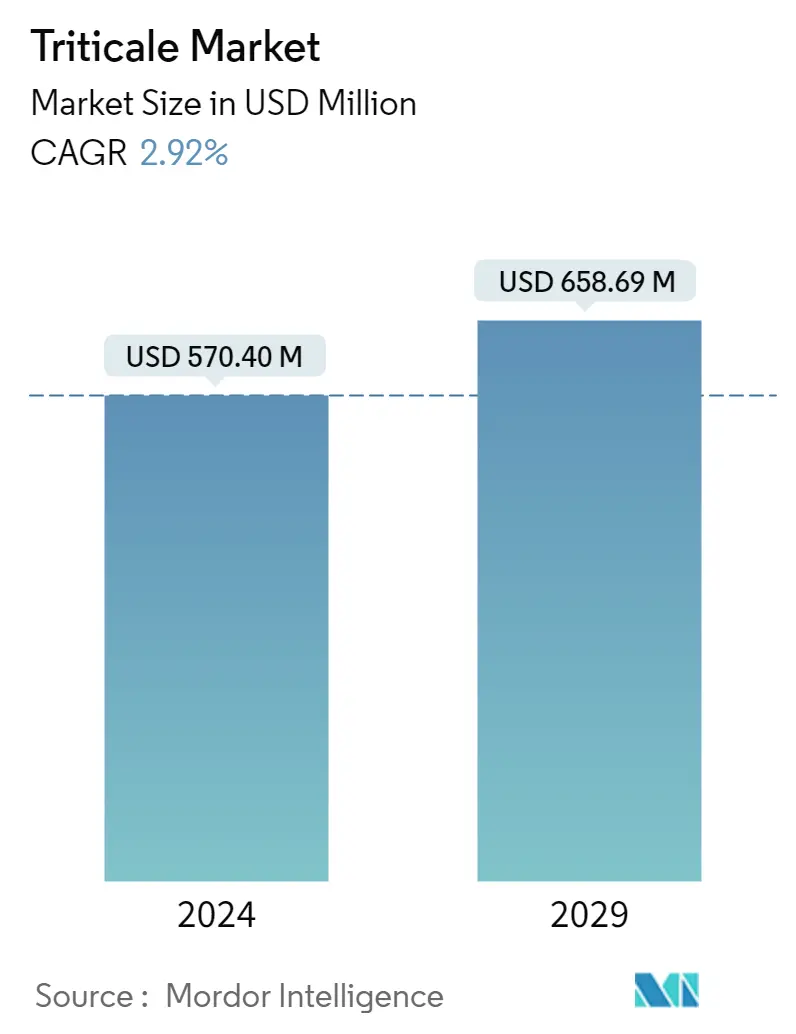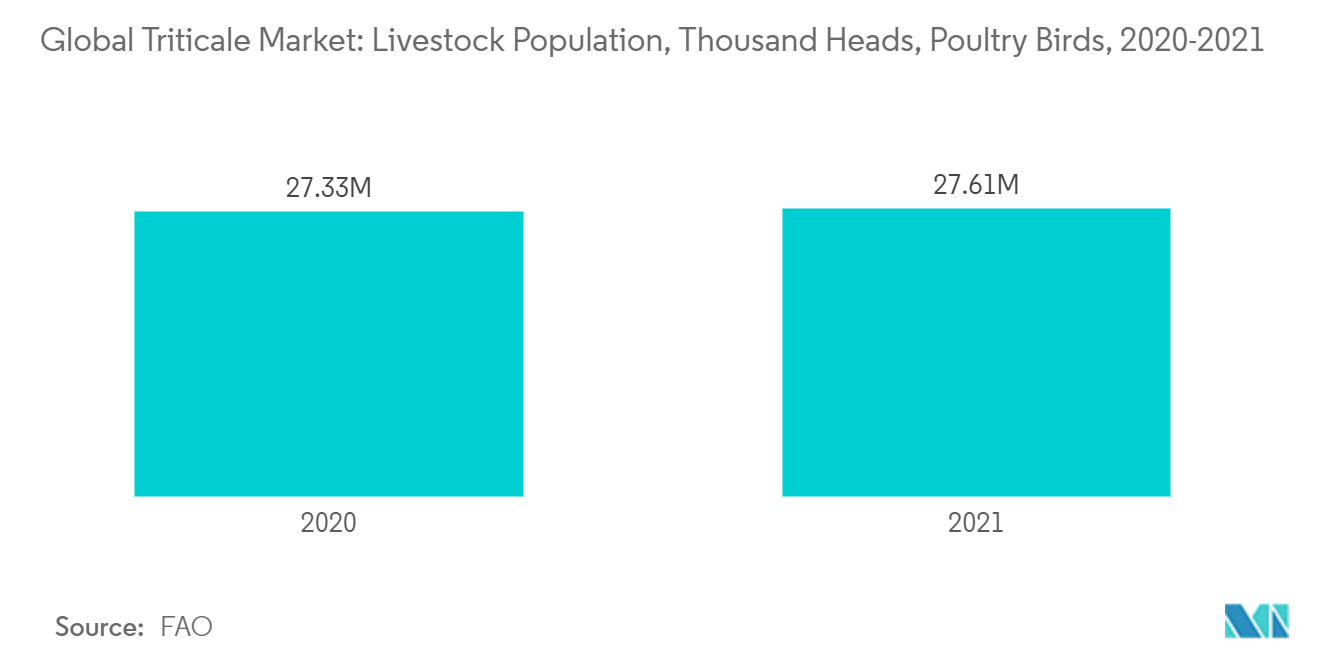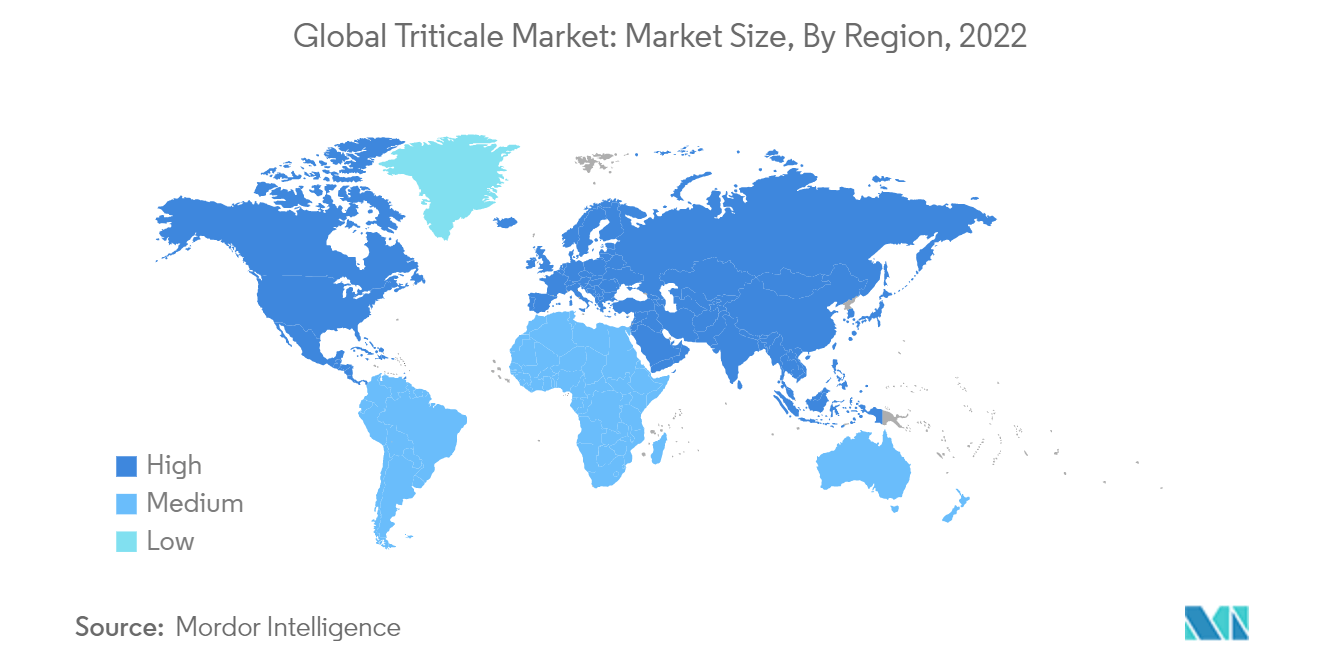Triticale Market Size

| Study Period | 2019 - 2029 |
| Market Size (2024) | USD 570.40 Million |
| Market Size (2029) | USD 658.69 Million |
| CAGR (2024 - 2029) | 2.92 % |
| Fastest Growing Market | North America |
| Largest Market | Europe |
Major Players*Disclaimer: Major Players sorted in no particular order |
Triticale Market Analysis
The Triticale Market size is estimated at USD 570.40 million in 2024, and is expected to reach USD 658.69 million by 2029, growing at a CAGR of 2.92% during the forecast period (2024-2029).
- Triticale is gaining popularity among livestock growers across the globe as it can be used in animal feed. Triticale has digestibility and water-soluble sugars similar to oats and cereal rye. Additionally, triticale can also thrive in drought, low-fertile soil, attracting more forage and livestock growers. This increasing adoption of triticale in animal feed is one of the major driving factors for the global triticale market.
- The leaders in the production of this crop are Poland and Germany. These countries have developed varieties that have occupied the main niche in the feed industry, and it can be difficult for other countries to compete in this area. At the same time, there are some peculiarities - in particular, despite good immunity, triticale often picks up a disease such as snow mold, and sometimes it is affected by septoria. Because of this, breeders are constantly working on obtaining new, more resistant plant varieties.
- Geopolitical issues have become the primary driver for the spring wheat market and other grain markets, with signs of Russia increasing its war efforts in Ukraine, which will benefit the market and raise the market during the forecast period.
Triticale Market Trends
Increasing use of triticale in Animal Feed in North America
Triticale has been increasingly used in animal feed by livestock growers. This can also be used as a substitute for oats and cereal rye. In the United States, North Florida Research and Education Center have developed triticale varieties such as Trical 342 and Monarch, the majorly grown triticale varieties for forage.
According to a study conducted in Florida, North Dakota, and Canada, the performance of finisher pigs fed with triticale was similar to those fed with corn. The lower price of triticale compared to corn will attract more livestock growers to use triticale in animal feed. According to FAO, the global poultry birds populations was 27,329,218 Thousand Heads in 2021, which was slightly increased compared to the previous year. This will drive the market for North American triticale in the upcoming years.
Based on current knowledge of triticale grains used to produce concentrated animal feeds. As a forage plant, triticale has a higher yield than other real cereals; triticale should be sown with some of the grain legumes to increase the protein value of vegetative biomass. In Canada and the United States, certain areas under winter species of triticale serve as pasture for domestic animals, boosting the market in the coming years.

Europe is the Major Producer of Triticale
In Europe, Poland is the largest producer of triticale globally, and domestic crops of this cereal account for 1/3 of the global production and more than 40% of the Europe production, and the share of production structure increased to 55%.
According to the Food and Agriculture Organization of the United Nations (FAO), in 2020, Poland, Germany, and France accounted for nearly 60% of the global production of this cereal. Currently, triticale is one of the most cultivated cereals in Poland, occupying second place after wheat. The cultivation area of the crop occupies over 1.4 million hectares which was slightly increased compared to the previous year with 1.3 million hectares with a share of 19%, and more than 50% of crops are located in the Wielkopolskie, Mazowieckie, Łódzkie and Lubelskie Voivodeships.
The main factors causing changes in cereal consumption in Poland are fluctuations in the animal population and grain for sowing, which is used in the feed, biofuel, and processing industries. This will drive the market during the forecast period.

Triticale Market News
- October 2022: The advancement of bread baking technique through cutting-edge additives that improve bakery goods made with triticale flour and give them therapeutic properties, using the raw material supply of the Russian Federation's bakery sector getting high-demand and popularity grain crop on the world market.
- March 2022: Triticale is one of the most cultivated cereals in Poland. According to the Food and Agriculture Organization of the United Nations (FAO), Poland, Germany, and France account for nearly 60% of the global production of this cereal. Currently, Poland occupies second place after wheat. The popularity of triticale in Poland is reflected in the cultivation area, which remained at a high level with 1.4 million ha in 2021.
Triticale Market Report - Table of Contents
1. INTRODUCTION
- 1.1 Study Assumptions and Market Definition
- 1.2 Scope of the Study
2. RESEARCH METHODOLOGY
3. EXECUTIVE SUMMARY
4. MARKET DYNAMICS
- 4.1 Market Overview
- 4.2 Market Drivers
- 4.3 Market Restraints
- 4.4 Value Chain Analysis
5. MARKET SEGMENTATION
-
5.1 North America
- 5.1.1 United States
- 5.1.1.1 Production Analysis (Volume)
- 5.1.1.2 Consumption Analysis (Volume and Value)
- 5.1.1.3 Import Analysis (Volume and Value)
- 5.1.1.4 Export Analysis (Volume and Value)
- 5.1.1.5 Price Trend Analysis
- 5.1.2 Canada
- 5.1.2.1 Production Analysis (Volume)
- 5.1.2.2 Consumption Analysis (Volume and Value)
- 5.1.2.3 Import Analysis (Volume and Value)
- 5.1.2.4 Export Analysis (Volume and Value)
- 5.1.2.5 Price Trend Analysis
-
5.2 Europe
- 5.2.1 Poland
- 5.2.1.1 Production Analysis (Volume)
- 5.2.1.2 Consumption Analysis (Volume and Value)
- 5.2.1.3 Import Analysis (Volume and Value)
- 5.2.1.4 Export Analysis (Volume and Value)
- 5.2.1.5 Price Trend Analysis
- 5.2.2 Germany
- 5.2.2.1 Production Analysis (Volume)
- 5.2.2.2 Consumption Analysis (Volume and Value)
- 5.2.2.3 Import Analysis (Volume and Value)
- 5.2.2.4 Export Analysis (Volume and Value)
- 5.2.2.5 Price Trend Analysis
- 5.2.3 France
- 5.2.3.1 Production Analysis (Volume)
- 5.2.3.2 Consumption Analysis (Volume and Value)
- 5.2.3.3 Import Analysis (Volume and Value)
- 5.2.3.4 Export Analysis (Volume and Value)
- 5.2.3.5 Price Trend Analysis
- 5.2.4 Netherlands
- 5.2.4.1 Production Analysis (Volume)
- 5.2.4.2 Consumption Analysis (Volume and Value)
- 5.2.4.3 Import Analysis (Volume and Value)
- 5.2.4.4 Export Analysis (Volume and Value)
- 5.2.4.5 Price Trend Analysis
-
5.3 Asia-Pacific
- 5.3.1 China
- 5.3.1.1 Production Analysis (Volume)
- 5.3.1.2 Consumption Analysis (Volume and Value)
- 5.3.1.3 Import Analysis (Volume and Value)
- 5.3.1.4 Export Analysis (Volume and Value)
- 5.3.1.5 Price Trend Analysis
- 5.3.2 Australia
- 5.3.2.1 Production Analysis (Volume)
- 5.3.2.2 Consumption Analysis (Volume and Value)
- 5.3.2.3 Import Analysis (Volume and Value)
- 5.3.2.4 Export Analysis (Volume and Value)
- 5.3.2.5 Price Trend Analysis
6. MARKET OPPORTUNITIES AND FUTURE TRENDS
** Subject To AvailablityTriticale Industry Segmentation
Triticale is a hybrid of two kinds of cereal: wheat and rye. It can be cultivated for human consumption, as an ingredient for animal feed, forage, and as a cover crop. The global triticale market is segmented by geography (North America, Europe, and Asia-Pacific). The study includes production analysis (volume), consumption analysis (value and volume), export analysis (value and volume), import analysis (value and volume), and price trend analysis. The report offers the market size and forecast in value (USD million) and volume (metric ton).
| North America | United States | Production Analysis (Volume) |
| Consumption Analysis (Volume and Value) | ||
| Import Analysis (Volume and Value) | ||
| Export Analysis (Volume and Value) | ||
| Price Trend Analysis | ||
| North America | Canada | Production Analysis (Volume) |
| Consumption Analysis (Volume and Value) | ||
| Import Analysis (Volume and Value) | ||
| Export Analysis (Volume and Value) | ||
| Price Trend Analysis | ||
| Europe | Poland | Production Analysis (Volume) |
| Consumption Analysis (Volume and Value) | ||
| Import Analysis (Volume and Value) | ||
| Export Analysis (Volume and Value) | ||
| Price Trend Analysis | ||
| Europe | Germany | Production Analysis (Volume) |
| Consumption Analysis (Volume and Value) | ||
| Import Analysis (Volume and Value) | ||
| Export Analysis (Volume and Value) | ||
| Price Trend Analysis | ||
| Europe | France | Production Analysis (Volume) |
| Consumption Analysis (Volume and Value) | ||
| Import Analysis (Volume and Value) | ||
| Export Analysis (Volume and Value) | ||
| Price Trend Analysis | ||
| Europe | Netherlands | Production Analysis (Volume) |
| Consumption Analysis (Volume and Value) | ||
| Import Analysis (Volume and Value) | ||
| Export Analysis (Volume and Value) | ||
| Price Trend Analysis | ||
| Asia-Pacific | China | Production Analysis (Volume) |
| Consumption Analysis (Volume and Value) | ||
| Import Analysis (Volume and Value) | ||
| Export Analysis (Volume and Value) | ||
| Price Trend Analysis | ||
| Asia-Pacific | Australia | Production Analysis (Volume) |
| Consumption Analysis (Volume and Value) | ||
| Import Analysis (Volume and Value) | ||
| Export Analysis (Volume and Value) | ||
| Price Trend Analysis |
Triticale Market Research FAQs
How big is the Triticale Market?
The Triticale Market size is expected to reach USD 570.40 million in 2024 and grow at a CAGR of 2.92% to reach USD 658.69 million by 2029.
What is the current Triticale Market size?
In 2024, the Triticale Market size is expected to reach USD 570.40 million.
Which is the fastest growing region in Triticale Market?
North America is estimated to grow at the highest CAGR over the forecast period (2024-2029).
Which region has the biggest share in Triticale Market?
In 2024, the Europe accounts for the largest market share in Triticale Market.
What years does this Triticale Market cover, and what was the market size in 2023?
In 2023, the Triticale Market size was estimated at USD 554.22 million. The report covers the Triticale Market historical market size for years: 2019, 2020, 2021, 2022 and 2023. The report also forecasts the Triticale Market size for years: 2024, 2025, 2026, 2027, 2028 and 2029.
Triticale Industry Report
Statistics for the 2024 Triticale market share, size and revenue growth rate, created by Mordor Intelligence™ Industry Reports. Triticale analysis includes a market forecast outlook to 2029 and historical overview. Get a sample of this industry analysis as a free report PDF download.



